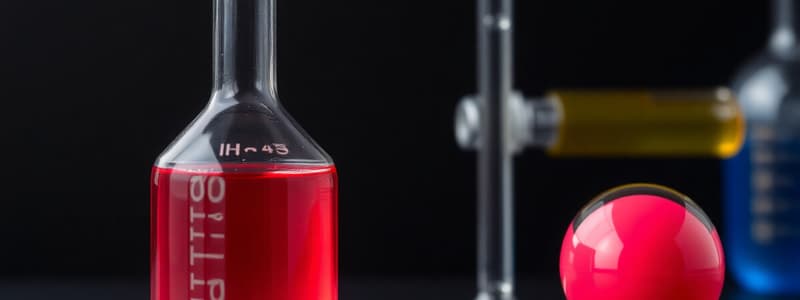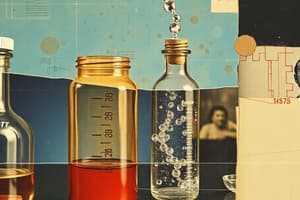Podcast
Questions and Answers
How does an increase in temperature generally affect reaction rates?
How does an increase in temperature generally affect reaction rates?
- It can either increase or decrease the reaction rate.
- It has no effect on the reaction rate.
- It decreases the reaction rate.
- It increases the reaction rate. (correct)
Which factor is likely to increase the reaction rate of a solid reactant?
Which factor is likely to increase the reaction rate of a solid reactant?
- Using a lower concentration of reactants.
- Decreasing the surface area.
- Increasing the surface area. (correct)
- Lowering the temperature.
What role do catalysts play in chemical reactions?
What role do catalysts play in chemical reactions?
- They are consumed during the reaction.
- They increase the activation energy required.
- They decrease the rate of reaction.
- They increase the rate of reaction without being consumed. (correct)
Which of the following accurately describes the rate law?
Which of the following accurately describes the rate law?
What effect does increasing the concentration of reactants have on reaction rates?
What effect does increasing the concentration of reactants have on reaction rates?
Which order of reaction exhibits a constant rate regardless of changes in reactant concentration?
Which order of reaction exhibits a constant rate regardless of changes in reactant concentration?
In the rate law Rate = k[A]^m[B]^n, the variables m and n represent what?
In the rate law Rate = k[A]^m[B]^n, the variables m and n represent what?
What is the effect of increasing pressure on gas reactions?
What is the effect of increasing pressure on gas reactions?
What happens to the reaction rate in a first-order reaction if the concentration of the reactant is doubled?
What happens to the reaction rate in a first-order reaction if the concentration of the reactant is doubled?
Which statement about reaction mechanisms is correct?
Which statement about reaction mechanisms is correct?
Which of the following statements about second-order reactions is true?
Which of the following statements about second-order reactions is true?
How does a catalyst influence the activation energy of a chemical reaction?
How does a catalyst influence the activation energy of a chemical reaction?
What is the significance of the rate constant (k) in a reaction?
What is the significance of the rate constant (k) in a reaction?
According to the Arrhenius equation, which factor directly increases the rate constant (k)?
According to the Arrhenius equation, which factor directly increases the rate constant (k)?
What primarily determines the overall rate of a reaction according to its mechanism?
What primarily determines the overall rate of a reaction according to its mechanism?
Which of the following best describes the relationship between temperature and the reaction rate?
Which of the following best describes the relationship between temperature and the reaction rate?
Flashcards
Temperature's Effect on Reaction Rate
Temperature's Effect on Reaction Rate
The increase in the rate of a chemical reaction due to higher temperatures. Higher temperatures provide more kinetic energy to reactant molecules, increasing the chance of successful collisions.
Concentration and Reaction Rate
Concentration and Reaction Rate
Increasing reactant concentration typically speeds up a reaction. More molecules packed together leads to more frequent collisions, increasing the chances of a reaction.
Surface Area's Influence on Reaction Rate
Surface Area's Influence on Reaction Rate
For solid reactants, increasing their surface area speeds up the reaction. More surface area means more contact with other reactants, leading to more collisions.
Catalysts: Speeding Up Reactions
Catalysts: Speeding Up Reactions
Signup and view all the flashcards
Pressure's Effect on Gas Reactions
Pressure's Effect on Gas Reactions
Signup and view all the flashcards
What is a Reaction Mechanism?
What is a Reaction Mechanism?
Signup and view all the flashcards
What is a Rate Law?
What is a Rate Law?
Signup and view all the flashcards
What is the Rate Constant (k)?
What is the Rate Constant (k)?
Signup and view all the flashcards
Zero Order Reaction
Zero Order Reaction
Signup and view all the flashcards
First Order Reaction
First Order Reaction
Signup and view all the flashcards
Second Order Reaction
Second Order Reaction
Signup and view all the flashcards
Activation Energy
Activation Energy
Signup and view all the flashcards
Catalysts and Activation Energy
Catalysts and Activation Energy
Signup and view all the flashcards
Rate Constant (k)
Rate Constant (k)
Signup and view all the flashcards
Arrhenius Equation
Arrhenius Equation
Signup and view all the flashcards
Reaction Mechanism and Rate-Determining Step
Reaction Mechanism and Rate-Determining Step
Signup and view all the flashcards
Study Notes
Factors Affecting Reaction Rate
-
Temperature: Higher temperatures increase reaction rates by providing more kinetic energy to reactant molecules. This leads to more frequent and energetic collisions, increasing the probability of successful reactions.
-
Concentration: Increasing reactant concentration increases reaction rate due to more reactant molecules in a given volume, leading to more collisions and a higher chance of successful reactions.
-
Surface Area: For solid reactions, increased surface area accelerates the reaction. A larger surface area exposes more reactant molecules, facilitating collisions and increasing the reaction rate.
-
Catalysts: Catalysts increase reaction rates without being consumed. They lower the activation energy, allowing more reactant molecules to achieve the necessary energy for reaction at a given temperature, accelerating the process.
-
Pressure: For gas reactions, increasing pressure increases reaction rate. Increased pressure forces gaseous molecules closer together, increasing collision frequency and reaction rate.
Reaction Mechanisms
-
A reaction mechanism details the pathway reactants transform into products through a series of elementary steps, involving bond breaking, bond forming, and intermediate formation.
-
Each step in the mechanism involves reactant collisions, influenced by factors like temperature, concentration, and catalysts.
Rate Laws
-
Rate laws describe the relationship between reaction rate and reactant concentrations. They are experimentally determined equations.
-
Rate law form:
Rate = k[A]^m[B]^nkis the rate constant (specific to a reaction and temperature).[A]and[B]are reactant concentrations.mandnare reaction orders and determined experimentally.- The overall reaction order is the sum of the individual orders (m + n).
Reaction Order
- Zero Order: Reaction rate is independent of reactant concentrations. The rate is constant.
- First Order: Reaction rate is directly proportional to the concentration of one reactant. A change in that reactant's concentration proportionally changes the reaction rate.
- Second Order: Reaction rate is proportional to the square of one reactant's concentration or the product of two reactants' concentrations. A change in concentration will change the reaction rate by the square. Doubling the concentration quadruples the reaction rate.
Activation Energy
-
Activation energy is the minimum energy required for a reaction to occur. It represents the energy barrier reactants must overcome.
-
Catalysts lower activation energy, making it easier for reactants to reach the required energy and speeding up the reaction at a given temperature.
Rate Constant
-
The rate constant (
k) is a proportionality constant in the rate law. It's unique to a specific reaction at a specific temperature. -
Higher
kvalues mean faster reaction rates under identical conditions. The rate constant is influenced by temperature as described by the Arrhenius equation.
Arrhenius Equation
- The Arrhenius equation describes the temperature dependence of the rate constant:
k = Ae^(-Ea/RT).Ais the pre-exponential factor (frequency of collisions).Eais the activation energy.Ris the ideal gas constant.Tis absolute temperature. Higher temperatures increasek, directly increasing reaction rate.
Reaction Mechanisms and Rate-Determining Step
-
A reaction mechanism is a series of steps showing how reactants transform into products.
-
The rate-determining step is the slowest step in the mechanism. The overall reaction rate depends on the rate of this slowest step.
Studying That Suits You
Use AI to generate personalized quizzes and flashcards to suit your learning preferences.




